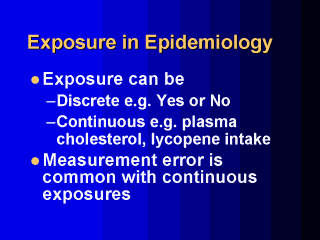| front |1 |2 |3 |4 |5 |6 |7 |8 |9 |10 |11 |12 |review |
 |
Measurement error is an important and common
source of bias in epidemiological studies. This is particularly so when measurements are
made with a laboratory test or an instrument (e.g. questionnaire) that is not considered
to be a gold standard. Because of this potential for error, it is important to always validate
the exposure measurements before detailed epidemiological analyses. Assessment and detection of error is usually achieved through validity and reproducibility studies on a sub-sample of study subjects. In such studies, measurements by the gold standard or an alloyed-gold standard (A) are compared with those from a field method (B) using correlation coefficients or by comparison of the means from the two methods. As we shall point out, these measures could be inaccurate if the two methods have correlated errors or if one of them has repeated measurements (which could also be correlated). In the following slides we will (a) describe a technique, the “method of triads”, that is used to reduce this limitation and (b) apply this method using an example from nutritional epidemiology. We will first describe the example used to illustrate the method. |